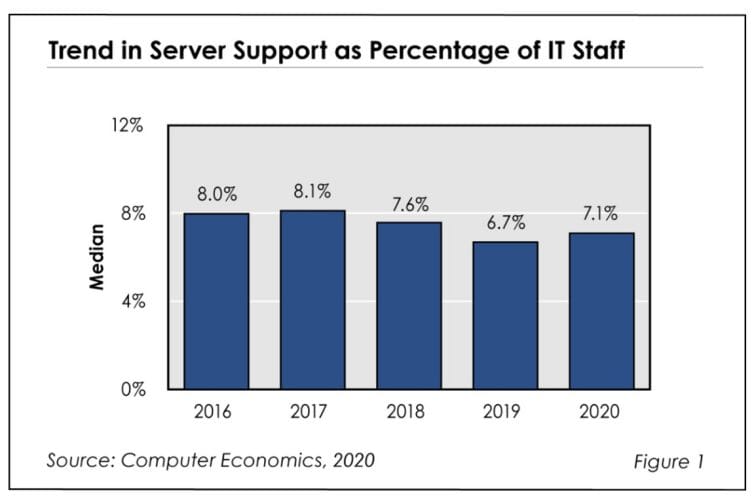The demand for server support administrators has ticked up this year, ending what had been a steady downward trend in since 2013. While it is likely that in the long run the trend toward reducing server support will continue, we would expect slower decreases in the future.
This is due to several factors. Many companies have already snatched the low-hanging fruit when it comes to moving to the cloud, which means they have adopted SaaS applications and have moved less-complex workloads to the cloud. But organizations are not transitioning remaining systems to the cloud as quickly as they transitioned to their first SaaS applications. The rest of the cloud migration is likely to continue on a slower-but-steady pace, and server support staff sizes will likely mirror that transition.
As shown in Figure 1 from our full report, Server Support Staffing Ratios, server support personnel as a percentage of the total IT staff ticked up slightly at the median from 6.7% in 2019 to 7.1% in 2020. Back in 2012, server support staff made up over 12% of IT staff (not pictured). This small uptick is not a reversal of that trend, but is likely a symptom of a slowing down of the trend.

“Many companies want to get out of the data center business, but few organizations have been able to completely eliminate their data centers,” said Tom Dunlap, director of research for Computer Economics, a service of Avasant Research, based in Los Angeles. “It is likely the overall trend will be toward reduction of server support staff, but don’t be surprised to see it happening in fits and starts.”
In this report, we use a broad definition for server support staff that covers the majority of employees in the data center. The category specifically includes systems administrators, systems programmers, systems engineers, storage administrators, and facilities engineers. It also includes computer operations staff, including computer operators, job schedulers, and production control personnel.
For this category, it also is important to understand who is excluded from the head count. Our count of server support staffing does not include database administrators, network support personnel, or communications system support personnel. Also excluded are IT managers, although shift supervisors and other data center managers are counted if they spend the bulk of their time doing the work as opposed to managing others.
To examine this important IT staffing question, the full report starts with an assessment of how server support staffing has changed over time. Next we provide four key metrics for benchmarking server support staff: server support staff as a percentage of the total IT staff, users per server support staff member, operating system (OS) instances per server support staff member, and physical servers per server support staff member. We provide these metrics for small, midsize, and large organizations. We also assess how industry sector can influence server support staffing ratios. We conclude with recommendations for improving server support productivity.
This Research Byte is a brief overview of our report on this subject, Server Support Staffing Ratios. The full report is available at no charge for Avasant Research subscribers, or it may be purchased by non-subscribers directly from our website (click for pricing).

